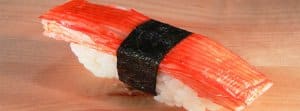Kanikama
What is Kanikama (or Surimi)

How Kani Is Made
The Surimi used to create Kanikama is composed mainly of Alaskan pollock, sourced from the north Pacific ocean. It includes smaller quantities of other white fish, as well as binding ingredients such as egg white and corn starch. Because it is composed of mainly white fish, Kanikami is colored with red food coloring to enhance its appearance. Kanikama is typically flavored with a crab flavoring, which is either artificial or derived from real crab, which allows it to mimic the taste of the more expensive ingredient.
The coloring used to brighten Kamikama is one of the indicators to tell if you are consuming real crab or imitation. Imitation crab will often have a bright red strip, whereas real crab has a light, pink tone on top. Another way to discern the two products is to look for muscle striation, or ridges or furrows in the meat. As imitation crab is made of ground fish, it will not have these irregularities.
But How Does Kani Taste?
The flavor of Kanikama is quite similar to that of real crab. It is mild and slightly sweet, and often lower in cholesterol than the real deal. Kanikama is low in fat as well. If you are newer to sushi, it is likely that you will be hard pressed to discern the difference in tastes and textures of Kanikama and more expensive real crab. This has led to the dramatic increase in use of imitation crab meat in sushi rolls.
While Kanikama is cheaper and very similar in taste to crab, one problem with it is that it’s hard to know exactly which chemicals and binding ingredients were used to create of the product. One of the charms of sushi is knowing exactly what you are eating in its pure and simple form, and while Kanikama is widely used in restaurants throughout the world, it does not have quite the same complex, nuanced, and subtle flavor as real crab meat.
